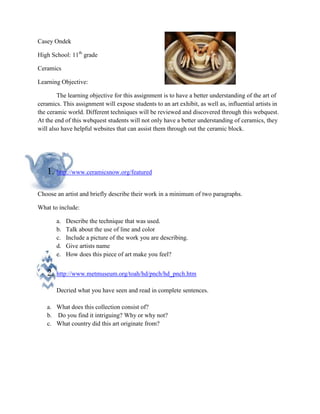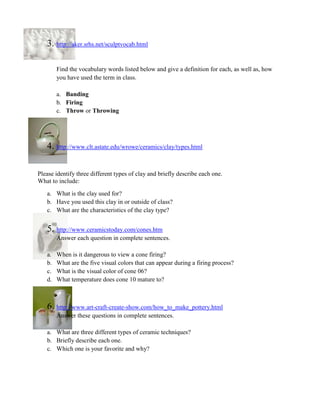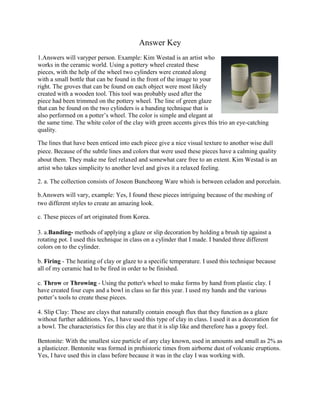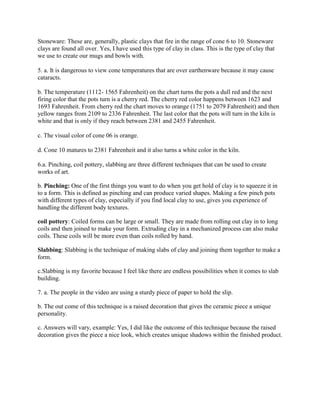Webquest 2___1_ (1)
- 1. Casey Ondek High School: 11th grade Ceramics Learning Objective: The learning objective for this assignment is to have a better understanding of the art of ceramics. This assignment will expose students to an art exhibit, as well as, influential artists in the ceramic world. Different techniques will be reviewed and discovered through this webquest. At the end of this webquest students will not only have a better understanding of ceramics, they will also have helpful websites that can assist them through out the ceramic block. 1. http://www.ceramicsnow.org/featured Choose an artist and briefly describe their work in a minimum of two paragraphs. What to include: a. Describe the technique that was used. b. Talk about the use of line and color c. Include a picture of the work you are describing. d. Give artists name e. How does this piece of art make you feel? 2. http://www.metmuseum.org/toah/hd/pnch/hd_pnch.htm Decried what you have seen and read in complete sentences. a. What does this collection consist of? b. Do you find it intriguing? Why or why not? c. What country did this art originate from?
- 2. 3. http://aker.srhs.net/sculptvocab.html Find the vocabulary words listed below and give a definition for each, as well as, how you have used the term in class. a. Banding b. Firing c. Throw or Throwing 4. http://www.clt.astate.edu/wrowe/ceramics/clay/types.html Please identify three different types of clay and briefly describe each one. What to include: a. What is the clay used for? b. Have you used this clay in or outside of class? c. What are the characteristics of the clay type? 5. http://www.ceramicstoday.com/cones.htm Answer each question in complete sentences. a. When is it dangerous to view a cone firing? b. What are the five visual colors that can appear during a firing process? c. What is the visual color of cone 06? d. What temperature does cone 10 mature to? 6. http://www.art-craft-create-show.com/how_to_make_pottery.html Answer these questions in complete sentences. a. What are three different types of ceramic techniques? b. Briefly describe each one. c. Which one is your favorite and why?
- 3. 7. http://www.youtube.com/watch?v=9czra-8DK94 Read the content on the page and watch the video too. Answer the questions in complete sentences. a. What type of material is used to hold the slip for this technique? b. Explain the out come of this technique. c. Did you like the finished pieces? Why or why not? 8. http://www.youtube.com/watch?v=j5gpu5ynCxg Watch the video and answer the questions using complete sentences. a. What temperature did the kiln reach before they pulled the pots out? b. Describe the cooling process for the two pots. c. How are American Raku kilns different from regular gas kilns? 9. http://digitalfire.com/4sight/material/ Answer each question in complete sentences. a. Why is it important to know how ceramic materials work? b. Why is material science important? i. Give an example from the reading or from your own experience. 10. http://www.ceramic-substrates.co.uk/ceramics.html Answer the questions in complete sentences. a. Give the definition for advanced ceramics. b. What are the advantages of advanced ceramics? c. Give a few examples.
- 4. Answer Key 1.Answers will varyper person. Example: Kim Westad is an artist who works in the ceramic world. Using a pottery wheel created these pieces, with the help of the wheel two cylinders were created along with a small bottle that can be found in the front of the image to your right. The groves that can be found on each object were most likely created with a wooden tool. This tool was probably used after the piece had been trimmed on the pottery wheel. The line of green glaze that can be found on the two cylinders is a banding technique that is also performed on a potter’s wheel. The color is simple and elegant at the same time. The white color of the clay with green accents gives this trio an eye-catching quality. The lines that have been enticed into each piece give a nice visual texture to another wise dull piece. Because of the subtle lines and colors that were used these pieces have a calming quality about them. They make me feel relaxed and somewhat care free to an extent. Kim Westad is an artist who takes simplicity to another level and gives it a relaxed feeling. 2. a. The collection consists of Joseon Buncheong Ware whish is between celadon and porcelain. b.Answers will vary, example: Yes, I found these pieces intriguing because of the meshing of two different styles to create an amazing look. c. These pieces of art originated from Korea. 3. a.Banding- methods of applying a glaze or slip decoration by holding a brush tip against a rotating pot. I used this technique in class on a cylinder that I made. I banded three different colors on to the cylinder. b. Firing - The heating of clay or glaze to a specific temperature. I used this technique because all of my ceramic had to be fired in order to be finished. c. Throw or Throwing - Using the potter's wheel to make forms by hand from plastic clay. I have created four cups and a bowl in class so far this year. I used my hands and the various potter’s tools to create these pieces. 4. Slip Clay: These are clays that naturally contain enough flux that they function as a glaze without further additions. Yes, I have used this type of clay in class. I used it as a decoration for a bowl. The characteristics for this clay are that it is slip like and therefore has a goopy feel. Bentonite: With the smallest size particle of any clay known, used in amounts and small as 2% as a plasticizer. Bentonite was formed in prehistoric times from airborne dust of volcanic eruptions. Yes, I have used this in class before because it was in the clay I was working with.
- 5. Stoneware: These are, generally, plastic clays that fire in the range of cone 6 to 10. Stoneware clays are found all over. Yes, I have used this type of clay in class. This is the type of clay that we use to create our mugs and bowls with. 5. a. It is dangerous to view cone temperatures that are over earthenware because it may cause cataracts. b. The temperature (1112- 1565 Fahrenheit) on the chart turns the pots a dull red and the next firing color that the pots turn is a cherry red. The cherry red color happens between 1623 and 1693 Fahrenheit. From cherry red the chart moves to orange (1751 to 2079 Fahrenheit) and then yellow ranges from 2109 to 2336 Fahrenheit. The last color that the pots will turn in the kiln is white and that is only if they reach between 2381 and 2455 Fahrenheit. c. The visual color of cone 06 is orange. d. Cone 10 matures to 2381 Fahrenheit and it also turns a white color in the kiln. 6.a. Pinching, coil pottery, slabbing are three different techniques that can be used to create works of art. b. Pinching: One of the first things you want to do when you get hold of clay is to squeeze it in to a form. This is defined as pinching and can produce varied shapes. Making a few pinch pots with different types of clay, especially if you find local clay to use, gives you experience of handling the different body textures. coil pottery: Coiled forms can be large or small. They are made from rolling out clay in to long coils and then joined to make your form. Extruding clay in a mechanized process can also make coils. These coils will be more even than coils rolled by hand. Slabbing: Slabbing is the technique of making slabs of clay and joining them together to make a form. c.Slabbing is my favorite because I feel like there are endless possibilities when it comes to slab building. 7. a. The people in the video are using a sturdy piece of paper to hold the slip. b. The out come of this technique is a raised decoration that gives the ceramic piece a unique personality. c. Answers will vary, example: Yes, I did like the outcome of this technique because the raised decoration gives the piece a nice look, which creates unique shadows within the finished product.
- 6. 8. a. They took the pots out of the kiln after the kiln got to 1932 Fahrenheit. b. The cooling process starts with taking the ceramic pieces out of the kiln at the peak temperature. Then the pieces are transferred to the cans that are full of sawdust and from here the pieces slowly cool down. c. American Raku kilns are always fired outside where as a gas kiln is usually found inside. American Raku kilns either lift up to open them or they can be taken apart on the other hand the normal gas kilns have fixed doors. Both kilns heat the ceramics up however they each have separate purposes. 9. a. While knowing the chemistry of materials gives you control of most of the fired properties of glazes, knowing the physical and fired properties of materials gives you control of both fired and unfired properties of bodies (and of course of the physical properties of glaze slurries). b. Materials science needs to be put into context with all the levels of assessment: oxide, mineral, material, recipe and process. For example, consider the problem of ware cracking during drying, a body issue (not likely related to chemistry). The problem could be as simple as ware being dried unevenly, a process level problem. If the cracking is occurring because the body has been formulated with too much ball clay to make it practical to dry, that is a recipe level issue. If the cracking is occurring because one material has changed or been substituted, perhaps to a much smaller particle size alternative, that is a material level issue. If the cause of the problem is difficult to asses, then the mineralogy of the ingredient materials and their interactions may need to be studied and understood better to solve the problem. i. Consider the issue of glaze slurry that is settling quickly, powdering after drying and failing to adhere well to ware, these are happening because of lack of clay content. This problem is probably directly related to the fact that the glaze is also running off ware during firing (likely due to lack of Al2O3 and SiO2 in the glaze). Adding kaolin (which supplies both) will help suspend and harden the glaze and it will help stabilize it during firing, solving all the problems. In addition the glaze will also be more durable and less soluble. 10. a. Advanced ceramics consist of carbides (SiC), pure oxides (Al2O3), nitrides (Si3N4), non- silicate glasses and many others. These ceramics are usually enhanced to create better building materials. b. Ceramics offer many advantages compared to other materials. They are harder and stiffer than steel; more heat and corrosion resistant than metals or polymers; less dense than most metals and their alloys; and their raw materials are both plentiful and inexpensive. Ceramic materials display a wide range of properties, which facilitate their use in many different product areas.
- 7. c. Aerospace: space shuttle tiles, thermal barriers, high temperature glass windows, and fuelcells. Consumer Uses: glassware, windows, pottery, Corning¨ ware, magnets, dinnerware, ceramic tiles, lenses, home electronics, and microwave transducers. Automotive: catalytic converters, ceramic filters, airbag sensors, ceramic rotors, valves, spark plugs, pressure sensors, thermistors, vibration sensors, oxygen sensors, safety glass windshields, piston rings.






